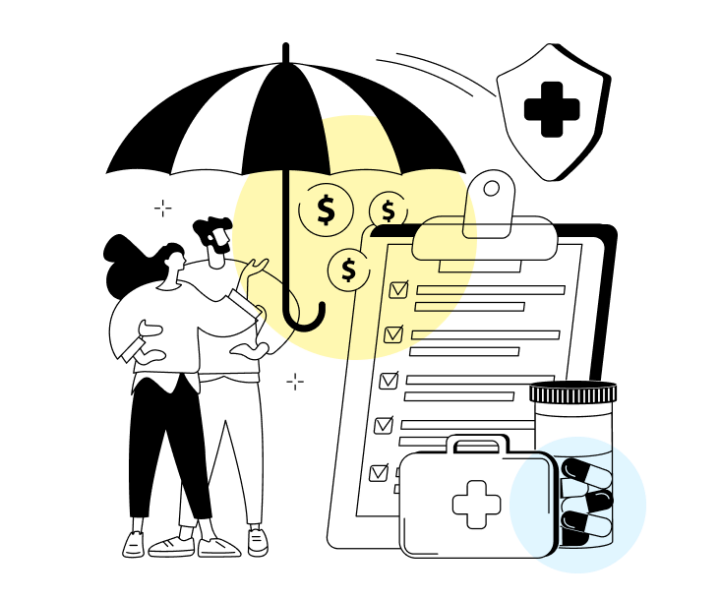Medical Expenses & Taxes in Canada – METC & Eligible Expenses
TurboTax Canada
February 6, 2025 | 3 Min Read
Updated for tax year 2025

Medical expenses can come at us from out of the blue. A chipped tooth, getting eyeglasses, hearing aids, prescription medication for ADHD, or acne. What happens when you have the sudden, but urgent need for crutches, a knee brace, or a personal support worker?
While Canadians have the privilege of universal healthcare, not all procedures, medications, assessments, and therapies are covered. So we’re often left to reach into our own pockets, especially if we don’t have private insurance.
The good news is that many medical expenses and costs can be deducted on your tax return.
Here’s what you need to know about how these credits work and how they can help lower your tax bill during tax time.
Key Takeaways
- Many obvious and not-so-obvious medical expenses can be claimed under the Medical Expense Tax Credit (METC).
- Getting into the habit of collecting health-related expenses can help lower your tax bill and get you the best possible tax outcome for you and your loved ones.
- Bring expenses from two calendar years into one, to eliminate the 3% minimum threshold in the second year of expenses.
What are the eligible medical expenses in Canada?
When dealing with a health issue, you’re probably not thinking about keeping track of receipts. But did you know there are countless medical expenses, ranging from common (prescription medications and medical aids) to not-so-common (service animals, orthopedic shoes, baby breathing monitors) that you can legitimately write-off?

Read the Full List of Medical Expenses to Claim on Your Tax Return
Read Now
Even most dental expenses are deductible, as long as they’re not cosmetic. And they all add up at tax time so you can save money on your taxes.
Tip: Ask your pharmacist as well as other health practitioners you visit for an annual statement of account to fast-track your calculations!
What is the Medical Expense Tax Credit (METC)?
The deductible medical expenses are considered a non-refundable tax credit, meaning they can help lower how much taxes you’d have to pay.
To qualify, for tax year 2025 your household’s eligible medical expenses must add up to the lesser of 3% of your net income or $2,833. For example, if your net income is $60,000, all medical expenses beyond $1,800 are a credit against your taxable income.
Many people don’t bother calculating their expenses to claim the METC because they assume they won’t meet the 3% threshold. But there are so many legitimate medical expenses—like car mileage and caregiver lodging for out-of-town appointments — that most people don’t think about or know about.
So try your best to keep track of receipts and document your expenses. They’ll add up quickly to help you surpass the all-important 3% mark!
TIP: If you’re part of a group health insurance plan at work, you may also have a medical expense to claim, reported on your T4 Box 85.
How to make the most out of your medical expenses?
Unlike other deductible expenses, medical expenses don’t have to follow a calendar year. The CRA lets you pick the 12-month period to claim these expenses.
For example: Let’s say your family had a ton of medical expenses from November until March. Both kids got braces, your spouse spent a bundle on glasses, and you needed physiotherapy due to a fall. If you had to follow the calendar year, the 3% rule would apply to the expenses of two different tax years.
By making your 12-month period from November 1 to October 31, you’ll be able to lump all the expenses together on one return (lines 33099 and 275 for Quebec), so the total is more likely to exceed the 3% threshold—at which point the METC kicks in.
Here’s what we mean:
Let’s say your 3% threshold is the same in both year one and two, being $2,250.
- Year one expenses = $8,400
- Year two expenses = $7,775
If you claim each year independently, you’ll have to deduct the 3% in both years:
- Year 1 months 7–12 = $6,150 ($8,400-$2,250)
- Year 2 months 1–6 = $5,525 ($7,775-$2,250)
If you combine the two years, you’ll only reduce the total claim by 3% at one time.
- Year 1 and 2 =$13,925 [($8,400+$7,775)-$2,250]
It may be more advantageous to bring expenses from two calendar years into one, to eliminate the 3% minimum threshold in the second year of expenses.
Remember to include 12 consecutive months over two years, and to stay consistent in future years to ensure there are no duplicate claims.
While keeping track of medical receipts may seem like a mundane task, getting into the habit of tallying health-related expenses can help lower your tax bill and get you the best possible tax outcome for you and your loved ones.
Think of it as a healthy habit. If you need extra support this year, our TurboTax experts are here to help.
Let an expert take taxes off your plate.
Get every dollar you deserve with our Full Service Guarantee. Your tax expert won't file your return unless you're getting every dollar you deserve, guaranteed.1
Get Started1 See Terms of Service for details.
Related articles

© 1997-2024 Intuit, Inc. All rights reserved. Intuit, QuickBooks, QB, TurboTax, Profile, and Mint are registered trademarks of Intuit Inc. Terms and conditions, features, support, pricing, and service options subject to change without notice.
Copyright © Intuit Canada ULC, 2024. All rights reserved.
The views expressed on this site are intended to provide generalized financial information designed to educate a broad segment of the public; it does not give personalized tax, investment, legal, or other business and professional advice. Before taking any action, you should always seek the assistance of a professional who knows your particular situation for advice on taxes, your investments, the law, or any other business and professional matters that affect you and/or your business.









